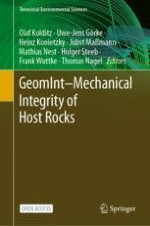6.1 Synthesis—Directions
6.1.1 Numerical Methods Competencies
Methods | Crack representation | Failure criteria | Mesh | Fracture apert. |
|---|---|---|---|---|
LEM | Element separation | Element strength | Lattice | Direct |
DEM | Element separation | Element strength | Discrete | Direct |
SPH | Particle based | NA | NA | Particle based |
FEM-LIE | Element explicit | Cohesive law | Conforming | Direct |
FEM-VPF | Damage variable | Fracture mechanics | Non-conf. | Indirect |
FEM-NLD | Damage variable | Stress based | Non-conf. | Indirect |
FEM-HDF | Element explicit | Cohesive law | Non- & conf. | Direct |
Rock type | Crack PD | Crack UD | Leak-off | Non-brittle | Visc. diss. |
|---|---|---|---|---|---|
Clay (WP1) | Yes | Yes | Maybe | Yes | Yes |
Salt/Clay (WP2) | Yes | Yes | Yes | Yes | Yes |
Crystalline (WP3) | Yes | Yes | Maybe | No | Maybe |
Method | Crack PD | Crack UD | Leak-off | Non-brittle | Visc. diss. | 3D | HPC |
|---|---|---|---|---|---|---|---|
LEM | \(\checkmark \) | \(\checkmark \) | \(\checkmark \) | \(\checkmark \) | \(\checkmark \) | \(\checkmark \) | \(\checkmark \) |
DEM | \(\checkmark \) | \(\checkmark \) | \(\checkmark \) | \(\checkmark \) | \(\checkmark \) | \(\checkmark \) | \(\checkmark \) |
SPH | \(\checkmark \) | \(\checkmark \) | \(\checkmark \) | \(\checkmark \) | \(\checkmark \) | \(\checkmark \) | \(\checkmark \) |
FEM-LIE | \(\checkmark \) | \(\times \) | \(\checkmark \) | \(\checkmark \) | \(\checkmark \) | \(\times \) | \(\times \) |
FEM-VPF | \(\checkmark \) | \(\checkmark \) | \(\checkmark \) | \(\checkmark \) | \(\checkmark \) | \(\checkmark \) | \(\checkmark \) |
FEM-NLD | \(\checkmark \) | \(\checkmark \) | \(\checkmark \) | \(\checkmark \) | \(\checkmark \) | \(\times \) | \(\checkmark \) |
FEM-HDF | \(\checkmark \) | \(\times \) | \(\checkmark \) | \(\checkmark \) | \(\checkmark \) | \(\checkmark \) | \(\checkmark \) |
-
fracturing process details, i.e. initiation and propagation
-
process coupling, i.e. THMC
-
scale of application
6.1.2 Proof-of-Concepts
6.1.3 International Collaboration
6.2 GeomInt Outlook—Future Work
-
experiments: The focus is on the evaluation of the latest in-situ experiments in the rocklaboratories Mont Terri (Opalinus Clay), Springen (salt) and Reiche Zeche (crystalline). Selected laboratory experiments are planned in order to specifically close still existing knowledge gaps (e.g. mechanical anisotropy of clay rocks).
-
modelling: Numerical methods are to be further developed and applied for in-situ use in a focused manner. For the scaling from micro- to macroscale models, different model approaches are to be specifically linked together (e.g. integration of the LEM in the FE method).
-
digitization: New developments in computer science, such as high-performance computing and visual data analysis, will be incorporated into the continuation of the project. This is necessary on the one hand to achieve the necessary scaling of the models (from micro to macro scale) and on the other hand to allow the representation of the model results in the real context of the underground laboratories.
-
Internationalization: In addition, international cooperation with the Mont Terri project and DECOVALEX 2023 will be intensified, also to increase the visibility of the Geo:N project.
